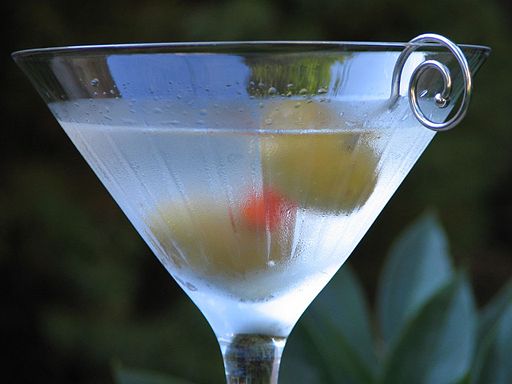Drink of the Week: The Olivette
 I’ve slipped up again in the holiday boozing department as there’s nothing particularly Father’s Day appropriate about today’s drink. Of course, there’s also nothing particularly un-fatherly about it. If dad likes gin, olives, and isn’t averse to a tiny bit of anisette/licorice flavor, he might just dig this very sophisticated, very boozy classic martini alternative as much as I do if you serve it up to him this Sunday.
I’ve slipped up again in the holiday boozing department as there’s nothing particularly Father’s Day appropriate about today’s drink. Of course, there’s also nothing particularly un-fatherly about it. If dad likes gin, olives, and isn’t averse to a tiny bit of anisette/licorice flavor, he might just dig this very sophisticated, very boozy classic martini alternative as much as I do if you serve it up to him this Sunday.
And I do kind of dig it. I wrote last week of my moody martini disenchantment and I’ve found this drink perhaps the perhaps the perfect antidote. It features my favorite part of the martini, the olive, but it’s balanced out by tiny proportions of sugar water and the alcoholic punch in the face we call absinthe. It does come from “The Savoy Cocktail Book,” definitely one of the big daddies of the field. I’ve modified it ever so slightly to better suit my personal taste buds. More about that after today’s recipe.
The Olivette
1 1/2 ounces Plymouth Gin
1/2 teaspoon simple syrup
1/4-1/2 teaspoon absinthe
2 dashes orange bitters
1 olive (mandatory garnish)
1 lemon peel (semi-mandatory garnish)
Combine the liquid ingredients and shake the contents. (You can also stir this drink if you like…but you’d be wrong.) Strain into a chilled, smallish cocktail glass or coupe over an olive. Mr. Craddock said you should squeeze the lemon peel on top, and I’m inclined to agree. Toast the olive, for it is green, pimento stuffed, and full of life…or, you can toast your dad if you’re so inclined.
***
I find the Olivette as wonderfully sophisticated as the best traditional dry martini, yet with far more flavor going for it. While the simple syrup might seem a counterintuitive touch for a drink with an olive in it, it creates a very pleasing balance with the orange bitters (Reagan’s for me, as usual) and the very strong anisette flavor of absinthe.
I’ve altered the Olivette from Harry Craddock’s recipe. Instead of my half and quarter teaspoons, the original calls for two dashes of simple syrup and three dashes of absinthe. I remain eternally befuddled by how I’m supposed to include a dash of something that doesn’t come from a dash bottle and too lazy/cheap to buy one just for the purpose of duplicating Mr. Craddock’s recipes. I prefer being a bit more precise anyway.
Even so, when I tried approximating the original drink with 1/4 teaspoon simple syrup and 1/2 teaspoon absinthe, I found the latter ingredient somewhat overpowered the drink. If you’re a bigger fan of licorice than me, however, you might like it this way. I liked the drink a whole lot better when I reversed the proportions and used 1/2 teaspoon of sugar and just 1/4 teaspoon absinthe — for me the ultimate example of a “little goes a long way” ingredient.
Of course, the primary and most important ingredient of the Olivette is gin, and not just any gin. Plymouth Gin is called for in, we are told by whomever felt like taking the time to count, 23 of the cocktails in “The Savoy Cocktail Book.” It is, as I wrote last year, both a style and a brand of gin. That’s because there’s only one brand of it available, so we’ve essentially got a monopoly on our hands. In this case, the monopoly works very nicely.
The ever-so-slightly less dry, fruitier flavor of gin from the English town that produced our nation’s ultra-abstemious founding Puritans really does seem to be the ideal gin for this lost classic of a drink. I say this with some authority because I also tried the Olivette with a perfectly good brand of regular London dry gin. It kind of tasted like a Dow Chemical spill.
You can follow us on Twitter and Facebook for content updates. Also, sign up for our email list for weekly updates and check us out on Google+ as well.
Posted in: Food & Drink, Lifestyle, Vices
Tags: absinthe, cocktails, Drink of the Week, gin, Happy Hour, lemon peel, olives, Olivette Cocktail, orange bitters, Plymouth Gin, Regan's Orange Bitters, simple syrup

 Pour gin/vodka and vermouth over ice into cocktail shaker, along with a dash or two of orange bitters if you’ve got them. Shake or stir very vigorously and strain into chilled martini glass or, for smaller portions, a wide-mouthed champagne glass, add olive(s) or lemon twist. Always serve up — i.e., without ice. (We know people who drink martinis on the rocks, but we’ve tried them that way and think they’re wrong. Very, very wrong.)
Pour gin/vodka and vermouth over ice into cocktail shaker, along with a dash or two of orange bitters if you’ve got them. Shake or stir very vigorously and strain into chilled martini glass or, for smaller portions, a wide-mouthed champagne glass, add olive(s) or lemon twist. Always serve up — i.e., without ice. (We know people who drink martinis on the rocks, but we’ve tried them that way and think they’re wrong. Very, very wrong.)








